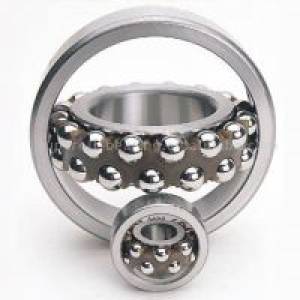Description
Self-Aligning Ball Bearings: Superior Performance and Reliability
Self-aligning ball bearings, also known as spherical roller bearings, offer exceptional performance and reliability in applications requiring misalignment compensation. Unlike standard ball bearings, these bearings accommodate angular misalignment, significantly reducing friction and wear, and extending operational lifespan. This detailed description highlights their key features, benefits, and applications.
Key Features:
- Self-Aligning Capability: The outer ring's spherical raceway allows for significant angular misalignment between the shaft and housing, accommodating shaft deflection, housing misalignment, or component settling. This inherent flexibility minimizes stress on the bearing and prevents premature failure.
- High Load Capacity: These bearings boast a high radial load capacity, making them suitable for heavy-duty applications. Their unique design distributes loads effectively, ensuring consistent performance even under demanding conditions.
- Low Friction: The smooth rolling action of the balls minimizes friction, leading to reduced energy consumption and improved efficiency. This translates to lower operating temperatures and increased bearing longevity.
- Easy Installation: Their design simplifies installation, often requiring less precision in alignment compared to standard bearings. This reduces assembly time and costs.
- Durable Construction: Typically manufactured from high-quality materials like chrome steel, these bearings are robust and resistant to wear and tear. They are designed to withstand harsh operating environments and prolonged use.
- Various Sizes and Configurations: Self-aligning ball bearings are available in a wide range of sizes and configurations, ensuring compatibility with a broad spectrum of applications. Options include single-row and double-row designs, each with specific load capacity and misalignment capabilities.
Benefits:
- Extended Bearing Life: The ability to accommodate misalignment reduces stress and wear, resulting in significantly longer bearing lifespan and reduced maintenance costs.
- Improved Efficiency: Low friction translates to reduced energy consumption, leading to cost savings and increased efficiency.
- Reduced Noise and Vibration: The smooth rolling action minimizes noise and vibration, contributing to a quieter and smoother operation.
- Simplified Maintenance: The robust design and extended lifespan contribute to reduced maintenance requirements.
- Increased System Reliability: By accommodating misalignment, these bearings improve the overall reliability of the machinery or equipment they are part of.
Applications:
Self-aligning ball bearings are extensively used in a diverse range of applications, including:
- Agricultural Machinery: Tractors, harvesters, and other heavy-duty equipment.
- Construction Equipment: Excavators, cranes, and loaders.
- Material Handling Equipment: Conveyors, lifting equipment, and forklifts.
- Automotive Industry: Axles, transmissions, and suspension systems.
- Industrial Machinery: Pumps, motors, and other rotating equipment.
- Food Processing Equipment: Mixers, conveyors, and packaging machines.
Choosing the Right Self-Aligning Ball Bearing:
Selecting the appropriate bearing requires careful consideration of several factors, including:
- Load Capacity: Determine the maximum radial load the bearing will experience.
- Misalignment Angle: Assess the level of angular misalignment the bearing needs to accommodate.
- Operating Speed: Consider the speed at which the bearing will operate.
- Operating Environment: Account for temperature, humidity, and other environmental factors.
By carefully considering these factors, you can ensure that you choose the optimal self-aligning ball bearing for your specific application, maximizing performance and longevity. Contact us for assistance in selecting the right bearing for your needs.
